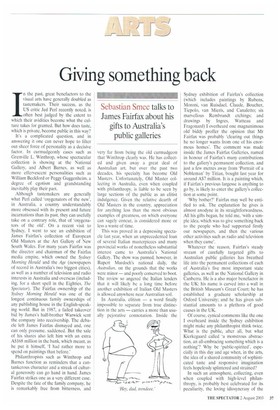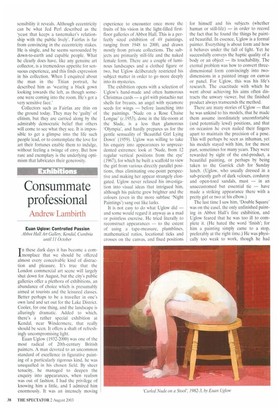Giving something back
Sebastian Smee talks to James Fairfax about his gifts to Australia's public galleries
1 n the past, great benefactors to the visual arts have generally doubled as tastemakers. Their success, as the US critic Jed Pen recently noted, is often best judged by the extent to which their avidities become what the culture takes for granted. But how does taste, which is private, become public in this way?
It's a complicated question, and in answering it one can never hope to filter out sheer force of personality as a decisive factor. In curmudgeonly cases such as Grenville L. Winthrop, whose spectacular collection is showing at the National Gallery, and Albert Barnes, as well as more effervescent personalities such as William Beckford or Peggy Guggenheim. a degree of egotism and grandstanding inevitably play their part.
Although tastemakers are generally what Perl called 'oxygenators of the new', in Australia, a country understandably more obsessed with its present and future incarnations than its past, they can usefully take on a contrary role, that of 'oxygenators of the old'. On a recent visit to Sydney, I went to see an exhibition of James Fairfax's collection of European Old Masters at the Art Gallery of New South Wales. For many years Fairfax was the director and chairman of the Fairfax media empire, which owned the Sydney Morning Herald and the Age (newspapers of record in Australia's two biggest cities), as well as a number of television and radio interests in Australia and overseas (including, for a short spell in the Eighties, The Spectator). The Fairfax ownership of the Sydney Morning Herald was one of the longest continuous family ownerships of any publishing house in the English-speaking world. But in 1987, a failed takeover bid by James's half-brother Warwick sent the company into receivership. The debacle left James Fairfax dismayed and, one can only presume. saddened. But the sale of his shares also left him with an extra AS168 million in the bank, which meant, as he put it himself, 'I had rather more to spend on paintings than before.'
Philanthropists such as Winthrop and Barnes function as reminders that a cantankerous character and a streak of cultural generosity can go hand in hand. James Fairfax strikes one as a very different case. Despite the fate of the family company, he is remarkably free from bitterness, and very far from being the old curmudgeon that Winthrop clearly was. He has collected and given away a great deal of Australian art, but over the past two decades, his specialty has become Old Masters. Unfortunately, Old Master collecting in Australia, even when coupled with philanthropy, is liable to be seen by large sections of the public as an elitist indulgence. Given the relative dearth of Old Masters in the country, appreciation for anything less than the most obvious examples of greatness, on which everyone can sagely concur, is considered more or less a waste of time.
This was proved in a depressing spectacle last year, when an unprecedented loan of several Italian masterpieces and many provincial works of nonetheless substantial interest came to Australia's National Gallery. The show was panned, however, in Rupert Murdoch's national daily. the Australian, on the grounds that the works were minor — and poorly conserved to boot. The review so angered the Italian lenders that it will likely be a long time before another exhibition of Italian Old Masters is allowed anywhere near Australian soil.
In Australia, elitism — a word finally impossible to separate from true distinction in the arts — carries a more than usually pejorative connotation. Inside the Sydney exhibition of Fairfax's collection (which includes paintings by Rubens, Moroni, van Ruisdael, Claude. Boucher, Tiepolo, van Miens, and Canaletto; six marvellous Rembrandt etchings; and drawings by Ingres, Watteau and Fragonard) I overheard one magnanimous old biddy proffer the opinion that Mr Fairfax was probably 'clearing out things he no longer wants from one of his enormous homes'. The comment was made inside the James Fairfax Galleries, named in honour of Fairfax's many contributions to the gallery's permanent collection, and just a few metres away from 'Portrait of a Nobleman' by Titian, bought last year for around A$7 million. It is a painting which. if Fairfax's previous largesse is anything to go by, is likely to enter the gallery's collection at some point.
'Why bother?' Fairfax may well be entitled to ask. The explanation he gives is almost anodyne in its straightforwardness. All his gifts began, he told me, 'with a simple idea, which was to give something back to the people who had supported firstly our newspapers, and then the various other activities such as radio and television when they came'.
Whatever the reason, Fairfax's steady stream of carefully targeted gifts to Australian public galleries has breathed life into the permanent collections of each of Australia's five most important state galleries, as well as the National Gallery in Canberra. He is a also major benefactor in the UK: his name is carved into a wall in the British Museum's Great Court; he has established a graduate scholarship at Oxford University; and he has given substantial amounts to a plethora of good causes in the UK.
Of course, cynical comments like the one I overheard inside the Sydney exhibition might make any philanthropist think twice. What is the public, after all, but what Kierkegaard called 'a monstrous abstraction, an all-embracing something which is a nothing'? Why be 'public-spirited', especially in this day and age when, in the arts, the idea of a shared community of sophisticated taste and responsive imagination feels hopelessly splintered and strained?
In such an atmosphere, collecting, even when coupled with high-level philanthropy, is probably best celebrated for its peculiarity, the loving idiosyncrasy of the sensibility it reveals. Although eccentricity can be what Jed Peri described as the 'yeast that keeps a tastemaker's relationship with the public lively', Fairfax is far from convincing in the eccentricity stakes. He is single, and he seems surrounded by down-to-earth and capable people. What he clearly does have, like any genuine art collector, is a tremendous appetite for sensuous experience, and this finds expression in his collection. When I enquired about the man in the Titian portrait, he described him as 'wearing a black gown looking towards the left, as though someone were coming into the room. He's got a very sensitive face.'
Collectors such as Fairfax are thin on the ground today. They may be 'guilty' of elitism, but they are carried along by the admirably democratic belief that others will come to see what they see. It is impossible to get a glimpse into the life such people lead, or to contemplate the love for art their fortunes enable them to indulge, without feeling a twinge of envy. But how rare and exemplary is the underlying optimism that lubricates their generosity.



























































 Previous page
Previous page